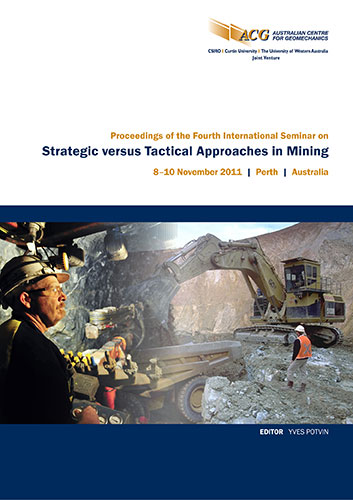Assessment of re-entry analysis procedures at an Australian mine

|
Authors: Pope, N; Wesseloo, J; Owen, M |
DOI https://doi.org/10.36487/ACG_rep/1108_11_Pope
Cite As:
Pope, N, Wesseloo, J & Owen, M 2011, 'Assessment of re-entry analysis procedures at an Australian mine', in Y Potvin (ed.), Strategic versus Tactical 2011: Proceedings of the Fourth International Seminar on Strategic versus Tactical Approaches in Mining, Australian Centre for Geomechanics, Perth, pp. 141-157, https://doi.org/10.36487/ACG_rep/1108_11_Pope
Abstract:
Seismicity caused by mining activity is a significant hazard to the safety of mining personnel and the sustainability of deep underground mines (Potvin, 2009). Following blasting there is an elevation in the level of seismicity as the rock mass responds to a change in mining void (Vallejos and McKinnon, 2008). Areas are typically evacuated during and after blasting, and re-entry analysis is the practice of defining the length of these exclusions of mining personnel based on the time taken for the rate of seismicity to return to a safe level. Re-entry analysis is simple in concept but difficult in practice. There is no absolute established ‘safe level’ of seismicity for re-entry as it depends onsite-specific factors. The various measures, such as event counts and cumulative energy plots, used to quantify the level of seismic activity over time are also dependent on the spatial and temporal criteria adopted for blast and seismic data selection. The objective of this study was to assess the efficacy of the existing re-entry criteria adopted by an underground mine. To achieve this goal, a retrospective study of 2,290 blasts at the mine was carried out. The subsequent recorded seismicity was analysed using a seismic event count method, applying Omori’s Law (Utsu, 1961) of seismic decay, in combination with plots of the total seismic energy following each blast. In addition, a ‘group event count’ method was applied to the data, assessing the seismic response from several blasts without reference to the cumulative seismic energy, in order to average the rock mass response and hence provide a broadly indicative re-entry time for relevant areas of the mine. It was found that, when analysing several blasts in close proximity to the area of interest to estimate a general re-entry time, more representative results were obtained by expanding the spatial envelope of included blasts beyond the current level-based (i.e. two dimensional) selection used by the mine. Re-entry estimations for all blasts were developed and plotted onto the mine plans, facilitating identification and estimation of the seismic response for future blasts. Through this work, a number of areas throughout the mine were highlighted as requiring more stringent seismic exclusions and/or further analysis, assisting the mine in prioritising risk mitigation measures.
References:
Heal, D., Hudyma, M. and Vezina, F. (2005) Seismic hazard at Agnico-Eagle’s Laronde mine using MS-RAP, in Proceedings CIM Maintenance Engineering and Mine Operators Conference, Sudbury, Canada, CIM.
Hudyma, M.R., Heal, D. and Mikula, P. (2003) Seismic monitoring in mines–old technology–new applications, in Proceedings 1st Australasian Ground Control in Mining Conference, Sydney, Australia, pp. 201–218.
Hudyma, M.R. (2008) Analysis and Interpretation of Clusters of Seismic Events in Mines, PhD Thesis, University of Western Australia, Perth.
Kgarume, T.E., Spottiswoode, S.M. and Durrheim, R.J. (2010) Statistical Properties of Mine Tremor Aftershocks, Pure and Applied Geophysics, Vol. 167, No. 1, pp. 107–117.
Potvin, Y. (2009) Strategies and Tactics to Control Seismic Risks in Mines, The Journal of The Southern African Institute of Mining and Metallurgy, Vol. 109, March 2009, pp. 177–186.
Utsu, T. (1961) A statistical study of the occurrence of aftershocks, Geophysical Magazine, Vol. 30, pp. 521–605.
Vallejos, J.A. and McKinnon, S.D. (2008) Guidelines for development of re-entry protocols in seismically active mines, in Proceedings of the 42nd US Rock mechanics symposium, ARMA/USRMS, June 2008, San Francisco, California, paper 08–97.
© Copyright 2025, Australian Centre for Geomechanics (ACG), The University of Western Australia. All rights reserved.
View copyright/legal information
Please direct any queries or error reports to repository-acg@uwa.edu.au
View copyright/legal information
Please direct any queries or error reports to repository-acg@uwa.edu.au